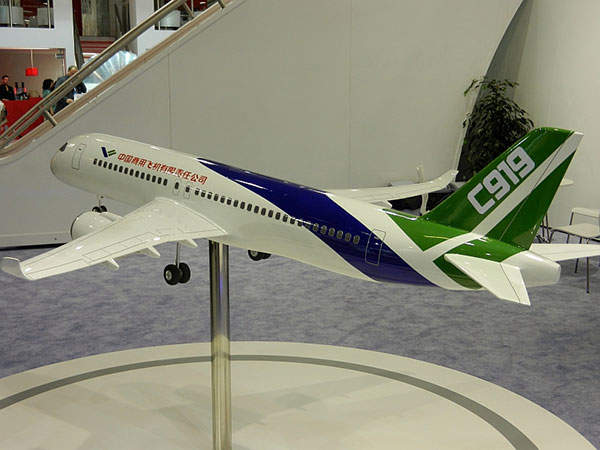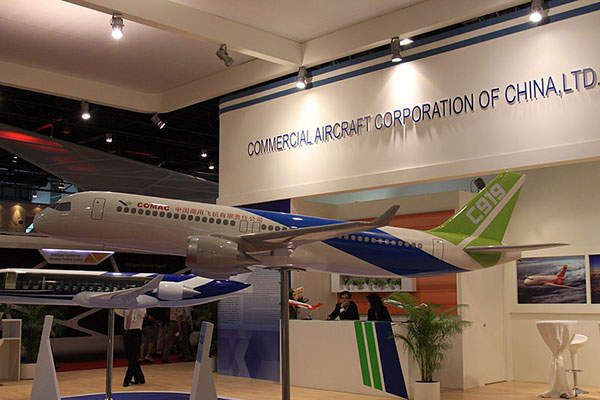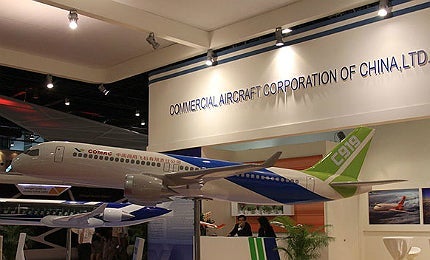C919 is a large passenger aircraft currently being developed by the Commercial Aircraft Corporation of China (COMAC). It will be a narrow-body aircraft with a seating capacity ranging between 168 and 190.
The first flight of the aircraft was expected to take place in May 2014, but has been delayed until the end of 2015. The aircraft is expected to enter service by 2017. The delay is attributed to a lack of experience and local industry-specific talent to execute the project.
In October 2010, COMAC applied to the Civil Aviation Administration of China (CAAC) for the type certificate for the C919 aircraft. The pilot production of the aircraft began in December 2011. The central wing structure of the aircraft passed the critical design review in January 2013.
In April 2010, Honeywell was awarded a contract to supply auxiliary power units (APUs) and other associated equipment for the aircraft.
In July 2010, Parker Aerospace, along with its joint venture partner China Aviation Industry Systems (AVIC Systems), was awarded with a contract to supply primary fly-by-wire flight control actuation, fuel inerting and hydraulic systems for the aircraft.
In February 2012, Liebherr-Aerospace was awarded with a contract to supply the landing gear and air management system for the C919 aircraft.
Orders and variants of the Chinese passenger aircraft
In 2010, COMAC received orders for 55 C919 aircraft from six airliners in China, which included China Eastern Airlines, CDB Leasing Company, Air China, GE Capital Aviation Services, Hainan Airlines and China Southern Airlines. Deliveries of the aircraft are expected to begin in 2016.
ICBC Leasing ordered for 45 C919s in October 2011. In November 2012, GE Capital Aviation Service ordered ten C919 aircraft. Hebei Airlines and Joy Air ordered 20 aircraft each. The C919 order book had 380 orders by November 2012.
The C919 is available in different versions, such as basic, extended, shortened, cargo, special version and corporate version. The dimensions and features vary with the versions to suit different types of customers.
Design and dimensions of the C919
The aircraft is being designed and developed in Shanghai. The aircraft’s centre and outer wing boxes, wing panels, ailerons and flaps are being manufactured at the Xi’an centre in China. The centre fuselage sections are being manufactured at Hongdu, also in China.
The airframe of the aircraft will be made of an aluminium alloy. The centre wing box will be made from carbon fibre composites.
The aircraft have a length of 38.9m, wingspan of 35.8m and a height of 11.95m. The fuselage of the aircraft will be 3.96m wide and 4.16m high. The dimensions of the aircraft are almost similar to those of Airbus A320.
Cabin and avionics of COMAC’s aircraft
The cabin of the C919 will be 3.9m wide and 2.25m high. The passenger model of the aircraft will accommodate up to 170 passengers. COMAC plans to build six different models of the aircraft, which will include business jets, passenger aircraft, shrunk passenger versions and freighters.
The avionics system of the C919 will be developed by GE and AVIC Systems. The avionics will include core processing, display and on-board maintenance systems. The aircraft will have modular avionics systems, such as central information system that will perform the avionics, maintenance and utility functions.
In July 2010, Eaton Corporation was awarded a contract to supply the cockpit panel assemblies and dimming control system for the aircraft in association with Shanghai Aviation Electric.
In October 2012, Rockwell Collins, in partnership with China Electronics Technology Avionics (CETCA), was awarded with a contract to manufacture communication and navigation systems for the aircraft.
C919 engine and performance
The aircraft will be powered by two CFM International LEAP 1C engines which will have a thrust of about 25,000lb to 30,000lb. The nacelle, thrust reverser and exhaust system of the aircraft engine will be provided by Nexcelle.
Michelin was awarded the contract to supply Air X radial tyres for the C919.
The aircraft will have a range of 4,075km (2,200nm). The payload of the aircraft will be 20.4t. The cruise speed of aircraft will be Mach 0.785 and the maximum altitude will be 12,100m. The range of the aircraft varies, from 4,075km for the basic version to 5,555km for the extended version.
Related content
Shenzhou Manned Spacecraft Programme, China
Shenzhou, which means Divine Vessel in Chinese, is a manned spacecraft programme initiated by the Republic of China in 1992.
Tu-204 Narrow Body Passenger Jetliner, Russian Federation
A twin engine, mid-haul narrow body jetliner, the Tupolev Tu-204 is designed and manufactured by the Tupolev Design Bureau of Russia.






